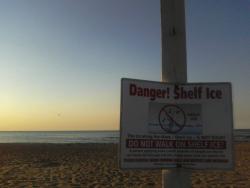  |
 Jun 6 2023, 08:12 AM Jun 6 2023, 08:12 AM
Post
#1
|
|
 Spends WAY too much time at CBTL       Group: Admin Posts: 16,421 Joined: 8-December 06 From: Michigan City, IN Member No.: 2 |
https://www.iflscience.com/the-mystery-of-h...unt-baldy-69169
QUOTE Nathan Woessner climbed up the Mount Baldy sand dune inside the Indiana Dunes National Park, where he quite suddenly disappeared. The boy fell into a sinkhole, where he remained trapped for more than three hours before being freed by rescue workers. Geo-scientist Erin Argyilan happened to be at the scene at the time studying wind speeds, the Smithsonian reports. Seven months pregnant, she went over to investigate the commotion, finding the parents attempting to dig their boy out of the sand. "Upon arriving at the site there were no obvious signs of disturbance at the surface to suggest a collapse of sediment," Argyilan and colleagues later wrote in a 2015 study on the sinkholes. "But the boy’s friend who was present at the time reported that they had seen an open hole, went to investigate its depth, and the boy slid out of sight into the hole which immediately infilled with sand." At the time, she told fieldworkers with her from the National Park Service that the incident "doesn't make any sense" given what we know about the formation of sand dunes. The dune was created as sand stacks up on top of sand, raising questions as to how a cavity formed underneath the sand's surface that was stable, until it wasn't and a sinkhole was formed. Argyilan decided to research the phenomenon herself, with a few clues to go on. The sand dune, which formed around 4,500 years ago, has roamed with the winds ever since. "Mount Baldy is a large parabolic dune that is rapidly migrating onshore over a late Holocene landscape with stabilized relict parabolic dunes that supported oak trees visible on the 1939 aerial photo," Argyilan explained in the paper. The phenomenon had been written about before, including in fiction. “You see, bub, this here was a pine forest a long, long time ago. These dunes didn’t useta be here, just trees. But the winds kept bankin’ the sand higher and higher and finally covered up the forest. Clean to the top of the trees," character Uncle Hank explained in Ken Kesey’s 1964 novel Sometimes a Great Notion about a boy who falls into a 'devil's stovepipe'. "And the trees eventually rotted out, leaving these hollows where they useta be, maybe just barely covered at the top”. Since the late 30s, aerial photographs showed the dune had enveloped the oak trees. Mount Baldy sand dune in 1939 and today. Aerial photographs showing the progression of Mount Baldy. Image credit: Argyilan et al., Aeolian Research, 2015 (CC BY-NC-ND 4.0) The oak trees had rotted away to make holes. What needed explaining, though, was that the gaps left remained stable. Examining the trees using scanning electron microscopy with energy dispersive spectroscopy, the team found the culprit. "Analyses of buried trees and surrounding sediment indicated that saprotrophic wood decay fungi continue to actively decompose trees after burial and biomineralization of a calcium-carbonate-rich cement occurs at the contact between organic material and sands," Argyilan and her team wrote. "We propose that, within the dune, portions of the decayed trees progressively collapse and infill, and open holes are temporarily stabilized by the calcium-carbonate-rich cement. Further, holes can exist undetected at the surface, covered by a thin veneer of sand." The team believes other "dune decomposition chimneys" – such as those found at Silver Lake State Park, Michigan, and the Oregon Dunes National Recreation Area, Oregon – could be caused by similar mechanisms, though that requires further investigation. As for the boy, who recovered, it turns out he was lucky. Or as lucky as you can be when being buried by a sinkhole. "Where continued vertical erosion intersected a void created from a vertically oriented tree trunk, dune decomposition chimneys could present a potentially unseen geologic hazard in heavily visited natural areas, as was the case in 2013 at Mount Baldy," the team concluded. "It is still our operating hypothesis that the boy was sustained by an air pocket; suggesting that he did not slide to the base of the hole and rather that there was void space beneath him." |
  |
2 User(s) are reading this topic (2 Guests and 0 Anonymous Users)
0 Members:
| Lo-Fi Version | Time is now: 22nd April 2024 - 11:18 PM |
Skin Designed By: neo at www.neonetweb.com
Invision Power Board
v2.1.7 © 2024 IPS, Inc.








